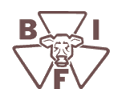What Drives Profit?
Rex Ranch manager shares things a cow-calf producer learns from owning a feedyard, urges cattlemen to adopt an abundance mentality.
by Troy Smith, field editor

“We learned that you can make improvement for specific genetic traits, within a genetic interval, using EPDs (expected progeny differences) and it will translate into added feedyard performance and profitability,” added Chip Ramsay, explaining how lost carcass quality and calving ease were regained.
MANHATTAN, Kan. (June 16, 2016) — Risk is inherent to the ranching business. According to Chip Ramsay, manager of the Whitman, Nebraska-based Rex Ranch, becoming further integrated in the beef business is a way to mitigate risk. By also owning a cattle-feeding enterprise, the parent company for Rex Ranch and several other cow-calf operations finds increased opportunity to add value and efficiency to the whole system, and to increase long-term profitability.
Ramsay explained the company’s 2010 entry to cattle feeding to an audience gathered in Manhattan, Kan., for the 2016 Beef Improvement Federation Annual Meeting and Symposium hosted June 14-17. He talked about what a rancher can learn after shifting from selling calves, yearlings and some custom-fed cattle to marketing only cattle fed through a company-owned feedlot.
“We learned quite a bit from 1995 to 2010 custom-feeding our calves in multiple feedyards and harvesting the cattle at multiple packing plants. However, since feeding our cattle in one yard for the past six years and harvesting at only two plants, we feel we are learning at a much faster pace than before,” offered Ramsay.
The experience has shown that cattle from different parts of the country must be fed differently; and environment of origin, as well as genetics, should also influence choice of implanting strategy. It is clear to Ramsay that nutritional environment matters, from conception to carcass. Feedyard data also shows that animal disposition and how cattle are handled influence performance.
“We learned that you can make improvement for specific genetic traits, within a genetic interval, using EPDs (expected progeny differences) and it will translate into added feedyard performance and profitability,” added Ramsay, explaining how lost carcass quality and calving ease were regained.
Ramsay said owning a feedyard has narrowed focus and simplified marketing at the ranch level. He credited the selling of fed cattle only, on a carcass basis, for simplifying the revenue equation. Owning the feedlot also has removed the challenges associated with some traditional antagonisms or mistrust between industry segments. Ramsay offered changes related to weighing cattle as examples.
If it doesn’t make logistical sense to run calves across a set of scales when shipping from ranch to feedyard, the historical shrink can be added to the off-truck weight at delivery. Ramsay called this method sufficient for the ranch’s data.
In preparation for shipment in extreme weather, cattle are gathered after they have had time to eat and water, thus lessening stress during transport. Feedyard processing protocols have been streamlined to avoid unnecessary repeat vaccinations. Since the cattle are marketed on a carcass-weight basis, finished cattle are not weighed prior to transport from feedyard to the packing plant. Forgoing taking weights prior to shipment has decreased stress, labor and dark-cutting carcasses.
Ramsay said so-called misfit cattle — animals that might otherwise be sorted from a group due to off-color or other lack of uniformity — are not treated differently. They are shipped and fed with other cattle of their same weight class.
“We’re trying to do what’s best for the cattle, instead of worrying about whether the buyer or seller gets an advantage,” stated Ramsay.
It’s part of an “abundance mentality” whose adoption, in Ramsay’s opinion, would benefit the beef industry. Creating added value is about making the pie bigger, he said, instead of trying to claim a bigger piece of the same pie.
Editor’s Note: This summary was written under contract or by staff of Angus Media. Through an agreement with the Beef Improvement Federation, we are encouraging reprinting of the articles to those who will adhere to the reprint guidelines available on this site. Please review those guidelines or contact Shauna Rose Hermel, editor, at 816-383-5270. PowerPoints are posted with permission of the presenter and may not be reproduced in whole or in part without the express permission of the presenter.
Angus Media's coverage of the event is made possible through collaboration with BIF and sponsorship of LiveAuctions.tv. For questions about this site, or to notify us of broken links, click here. Look for additional coverage in the Angus Journal, the Angus Beef Bulletin, the Angus Journal Daily, the Angus Beef Bulletin EXTRA and Angus TV.
.


